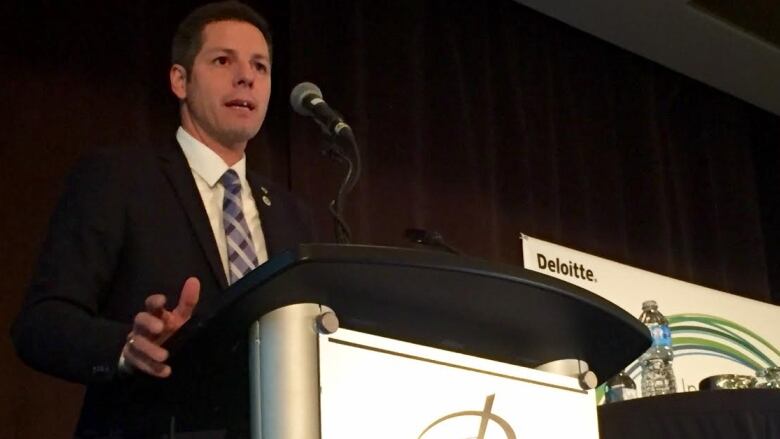Mayor was advised to attack or ignore Maclean's after Winnipeg declared most racist city
Bowman reflects on his 'year of reconciliation' during speech before business, government leaders

Mayor Brian Bowman says he was advised to attack or ignore Maclean's afterthe magazine declared Winnipeg Canada's most racist city in early 2015.
In a speech at the Delta Hotel on Thursdaymorning, Bowman told about200 businesspeople and government officials he received conflicting advice about how to proceed afterWinnipeg received the ignominous tag.
Bowman said he was initially angered by the story and took issue with several portions of it. He said he received some external advice to "attack the messenger" or "hide in his office" until the issue went away.
Bowman said he ultimately chose to go with the advice of the majority of his staffers and acknowledge the central point of the piece: Winnipeg has a lot of work to do in order to address the historic mistreatment of its Indigenous citizens and create an equitable partnership betweenIndigenous and non-Indigenous residentstoday.
"There were things in the article and characterizations of Winnipeg that we could have challenged, but in my view, that wouldn'thave allowed us to have the opportunity that we've had this year to really focus on trying to do a better job to combat racism," Bowman told reporters after the speech.
Bowman made the comments during and after a speechabout Winnipeg's "year of reconciliation," which is what henamed 2016 in the wake of the Maclean's story.
- Buffy Sainte-Marie calls for adults only exhibit on residential schools at Canadian Museum for Human Rights
- Maclean's claim that Winnipeg is Canada's most racist city upsets mayor
Bowman also told the audience treaties between Indigenous Canadians and newcomers were not supposed to be historical documents, but living guidelines for an active partnership. That partnership has been marred severely by racism, he said, and he encouraged business leaders to heed the calls to action made by the Truth and Reconciliation Commission.
The speech followedtheWednesday publication of aNew York Timesstory about the Canadian Museum for Human Rights that drew attention to the disjunction between the museum's goal and what critics call the institution's failure to address Indigenous stories and human-rightsstruggles.
"It occupies a prominent parcel in downtown Winnipeg, the capital of Manitoba, a province wheremore than 75 per cent of Aboriginal children live in poverty, the highest rate in Canada, according to a recent study," reporter Dan Levin wrote in the piece, which appeared on the newspaper's digital front page.
"Winnipeg, home to the nation's largest urban Indigenous population, has long struggled to overcome a racial divide, which both its Aboriginal mayor and the museumaretryingto healthrough educational and government programs."
Bowman, who visitedNew York City earlier this week to meet with bond raters, said he hadnot read the New York Times story.
"Knowing the leaders at the Canadian Museum for Human Rights, I have no doubt they're listening to that and that sort of feedback is not uncommon for a museum that deals with human rights," he said.
"I would expect and suspect that they're certainly listening to that feedback as they evolve the programs and the displays at the museum."












_(720p).jpg)


 OFFICIAL HD MUSIC VIDEO.jpg)
.jpg)



























































































